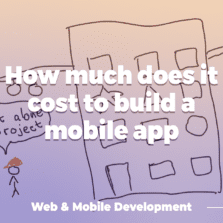

Developing an innovative product is truly a challenging task. An entrepreneur who wants to generate an idea and bring it to market has to answer the difficult question, “What does a person need?” In user response, entrepreneurs pay attention to the needs of the future consumer in different ways.
Companies often deploy creativity to understand their customers. According to Adobe, entrepreneurs who nurture and encourage creativity in their business culture have, on average, 1.5 times more market share. Today, OQTACORE will talk in detail about design thinking, a concept that entrepreneurs have borrowed from designers and are actively using as an engine for their creativity in business.
What is design thinking?
Let’s start with the definition. Design thinking is a human-centered process for identifying a user problem and finding its solution. The most important word here is “human-centered”. It means that coming up with ideas and finding solutions are based on user experience. So, you build on the “human first” principle and take into account the user’s vision of the problem at every step. By the way, this is also one of the reasons why the methodology is called “design thinking” – a modern design involves developing a sense of empathy towards your users when designing a product, creating spaces that are welcoming and reassuring.
Another important element of design thinking is finding a solution – this is not entirely analytical. It means that a decision is made not only on the basis of marketing and financial analysis, but also based on creative processes that could have resulted in the most unexpected solutions.
The concept of design thinking has turned out to be very flexible, and it has gone beyond the sphere in which it was invented. Entrepreneurs paid attention to it and began to use it in the process of finding and creating innovations. Indeed, it has really achieved business results. Data from McKinsey shows organizations that regularly follow design thinking practices see a third higher revenues and 56% more returns than those that don’t. And the most successful brands use it.
IBM, Google, Airbnb, PepsiCo and Nike are just some of the companies that see design thinking as a core part of their business culture. Former PepsiCo CEO, Indra Nooyi, noted in an interview with Harvard Business Review that the company used design thinking as a basis for decision-making. The company has enjoyed 80% revenue growth during her 12 years in the top job.
Formal methodology or something abstract?
No matter how effective design thinking seems, you, as an entrepreneur, should still remember one thing: design thinking processes are not a system of methods that must be followed in a strictly defined order. It’s simply an abstract approach – the basic idea that an entrepreneur must keep in mind when creating his product. For this reason, people who are trying to figure out design thinking normally ask: How do I use it? Yes, in the design thinking concept, different designers, entrepreneurs and researchers often highlight the stages, presenting it in the form of a model. However, these are also abstract and not formalized – there is no unified system, the number and names of stages vary among methodologists.
The stages are different in business and in design projects. Nevertheless, for the sake of better understanding, we’ll look at a DT model by German businessman and researcher Hasso Plattner for innovation. It is popular and illustrates what processes are most often highlighted in design thinking. The model includes the steps listed below. But remember, despite the description of each of the processes, you are not limited to them and can use them as you like.
Empathize
Study your users or consumers. The study is based on empathy, so qualitative methods are most often used here.
Define
The user information you have created and gathered during the Empathize stage is required in this stage. Users have a number of wicked problems, that is, problems with no clear formulation and no ready-made right or wrong solutions. You have been collecting data for the purpose of formulating these problems. So to do this, startups use the visual personas method, which UX designers and marketers often use.
Ideate
It’s time to generate ideas for the future solution. Emphasis should be placed on quantity – the more ideas and the more unconventional they are, the better the next stage would be. This is the most creative stage of all, so if your startup already has a team, gather all the members for brainstorming or sketching.
Prototype
After brainstorming, you should have a discussion and select the best ideas for testing. Prototypes will allow you to test them quickly and cheaply. In our social media accounts, we’ve talked about what these are and how they differ from MVP.
Test
You need prototypes to test your ideas. Find out from users what they like about the prototypes, which features are useful for them, and which are not. You need to identify the strengths and weaknesses of each of your ideas, so that in the end you could choose the one that best suits your audience.
If none of your proposed solutions work for the user, then in line with design thinking, you can just start over, retesting the prototype. Humans are rather complex creatures, so there’s nothing wrong with misinterpreting their needs and behaviors. Any step can be used an unlimited number of times.
How has Airbnb used design thinking?
Airbnb is often cited as the most classic example of design thinking. Its founders and, by the way, designers Brian Chesky and Joe Gebbia, were renting an apartment together in San Francisco. In 2007, the city was hosting a major design conference, and prices for hotel rooms went up big time. So the two friends decided to earn some money on this and at the same time to help their colleagues. They bought air mattresses so that guests could stay overnight at their place. And to make it easier for people to locate their apartment and book, Chesky and Gebbia created airbedandbreakfast.com.
The entrepreneurs did not stop there; they decided to develop the idea. Using the empathy method, they put themselves in the user’s shoes and asked themselves several questions:
- What do people do when they travel?
- How can they quickly and easily find their way from the airport to their home?
- On the Internet, how can one recommend a favorite spot on the next street for dinner?
And other, more or less specific questions.
Based on the responses received, the designers generated a number of ideas for improving their site. That is how one of the first versions introduced features that allow you to rent and select an apartment, communicate with the homeowner, and also a feature that lets both guests and owners write/check reviews. These are the main features that have made Airbnb popular.
This case demonstrates the speculative nature of the concept – Airbnb founders simply showed empathy for their user without using all the design thinking processes. They didn’t first collect data before generating ideas, they didn’t create a prototype or test it, because they didn’t need to go through all the steps either. The case of Airbnb shows that one can stop at using the main idea of design thinking – taking into account the user’s opinions and feelings.
Design thinking vs. lean startup
The difference is very hard to grasp, but it is there.
The first major difference is that lean startups don’t include generation of ideas based on pre-collected data about the consumer and his problem. Lean startup implies that the entrepreneur has formulated a business idea from scratch and already “sees” the future product, which also makes the lean startup concept quite abstract. How can an idea come up without user data? It’s not very clear.
For example, in design thinking, you first study the user, find out that they have a problem with searching for text files on their smartphone, then you ask yourself, “How can I improve the way I search for files on my smartphone?” and generate ideas. And in a lean startup, you immediately have the idea of creating an app that organizes files on a smartphone according to types.
The second main difference is that you need a lean startup to achieve product market fit. Since you already have a business idea in hand, you make a proposition about how well that idea would meet consumer needs, and then you test the hypothesis with the MVP.
The third main difference in methods is that lean startup emphasizes quantitative methods. And the basics of design thinking are the creative process, generation of non-standard ideas and qualitative research, which is aimed at a deep understanding of the person, not at obtaining numbers and statistics.
Conclusion
Even though design thinking is a very theoretical concept, which cannot be used as a formal methodology; this doesn’t mean it is useless and should be abandoned. The user or consumer is the important link, this is the main idea of design thinking and that’s what the biggest players in the market remember. Not only the idea and the decision are important, but also how they are accepted by the person – both logic and research speak to this.
Customer centricity helps you to build trust and loyalty of your customers and increase market share. According to Adobe, design-driven businesses excel at customer experience strategy. Half of the companies Adobe surveyed say design thinking creates more satisfied and loyal customers. And 41% cite increased market share as a benefit to having more advanced design practices. So it’s definitely not a concept to be thrown away.
OQTACORE creates a product that primarily incorporates the opinions and feelings of the end user. This is why we rely on all factors when implementing your ideas and suggestions – empathy allows us to greatly improve the product quality.






